Characteristics of Fired Bullet on Different Target Materials
NP Waghmare*, Kulbhooshan Gupta, Jagdeesh Naik and VR Anand
Goa State Forensic Science Laboratory, India
Submission: May 21, 2019; Published: July 25, 2019
*Corresponding author:NP Waghmare, Goa State Forensic Science Laboratory, Verna, Goa, Delhi, India
How to cite this article: NP Waghmare, Kulbhooshan Gupta, Jagdeesh Naik, VR Anand. Characteristics of Fired Bullet on Different Target Materials. J Forensic Sci & Criminal Inves. 2019; 12(2): 555833. DOI: 10.19080/JFSCI.2018.11.555833.
Abstract
In shooting incident, components of bullet were separated after firing through the ordinary windowpane. In this situation, it is very difficult to interpret and correlate the elements of glass and fragments of bullet found on or surrounding the target were fired through the glass target or any other hard target at the place of occurrence. In present investigation, standard 8mm/.315”, 9mm, .303”, .380”, 7.62x39mm and 7.62x51mm caliber projectiles were fired on commercial glass targets by respective regular firearms in the laboratory. It is observed that typical dimensions of lead core and jacketed portions were separated after fired through glass pane. The lead core and jacketed portions of soft nose bullets were either mutilated or deformed conditions. Similarly, other jacketed bullets also got deformed at nose portion without fragmentation of jacketed portions. In this paper, authors have been analyzed the nature and patterns of fired bullets or its components in the significance of forensic ballistics experts, crime scene managers, law enforcement of agencies etc.
Keywords: Glass Targets, Soft Nose Bullet, Jacketed Bullet, Ballistics Expert
Introduction
While sending forensic exhibits relating to firearms and ammunition to the forensic laboratory, Ballistics experts are frequently asked to determine the distance of firing, type and caliber of bullet, from which firearm it was fired. Practically, ballistics expert may compare the test-fired bullet directly with the questioned bullets, whose type and behavior are to be estimated [1]. Often the examination becomes easy for the forensic examiner when the bullet is got intact, and not in deformed or mutilated form or when some portions of the jacket missing are collected from the place of occurrence or the bullets recovered from the body of victims [2-4]. A review of the literature showed that comprehensive study on the various forensic ballistics test have been made in the past, but these were mostly linkages of crime bullets with the test bullets.
It has been stated and interpreted the made of fracture on terms of dynamical stress field in perforation of glass pane by bullet impact but they studied the perforation effect of .303”, .32’, .38” & .22” caliber bullets on the commercial glass sheets [5]. It is also stated that the perforation craters have always as well- defined shape with more or less constant semi angle which was independent of the projectile caliber, velocity and thickness of target material [6]. Earlier many workers undertook the study of the different projectiles on different targets by ammunition of Indian and foreign origin employing the well-known techniques and targets, but the study has not been done on different bullet fired through the different firearm on glass pane [7-8].
The crack should be entitled on the impact side as a ring rack which subsequently propagates following a dined trajectory just as in case [9].
The phenomena of penetration of bullet from the ordinary windowpane with different thickness available in India has been used in the present study and behavior of fired bullets through the glass is discussed in further study. A small arms bullets is cylinder conical in shape and endowed with a high rate of spin. When such type of bullet traverses a glass target, it makes a considerable difference and modified the basic values of various parameters.
Materials and Methods
Low as well as high velocity weapons of different calibers with respective ammunition such as, 9mm, .32”, .380”, .303”, .315”, 7.65x51mm, and 7.62x39mm caliber were test fired on 2mm thickness of glass pane which was hold in perpendicular to the direction of muzzle end of weapons.
The whole firing arrangement was made on heavy wooden carrying firing table. The controlled distance between glass pane and weapons were kept fixed about 5 meters keeping 90-degree angle to the muzzle of the gun. Recovered bullets and their jacketed portions were recovered from the bullet recovery box for further forensic analysis (Figure 1-65).
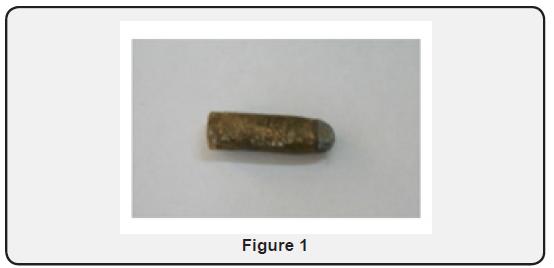
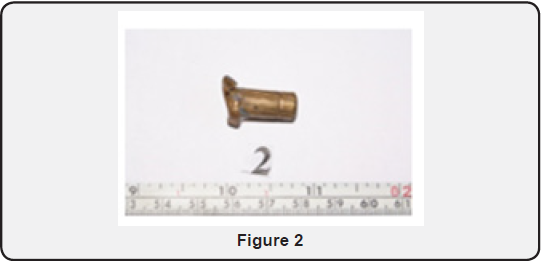

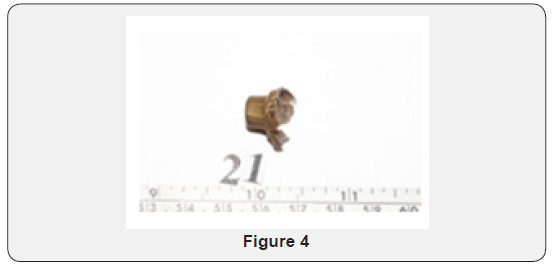

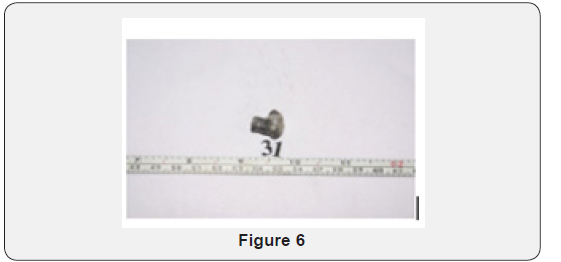
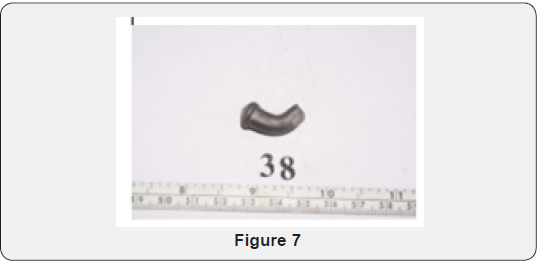
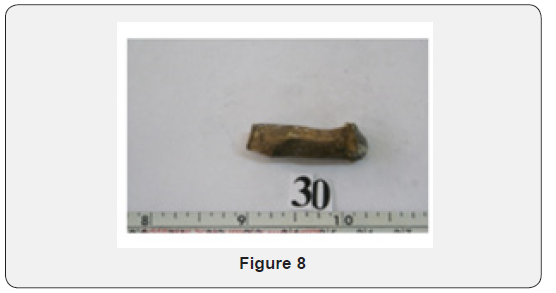

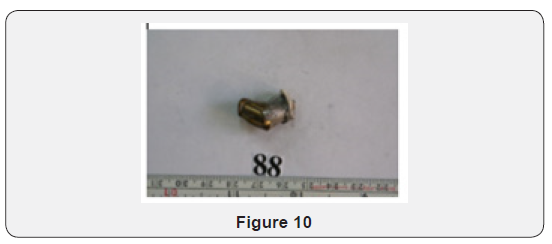
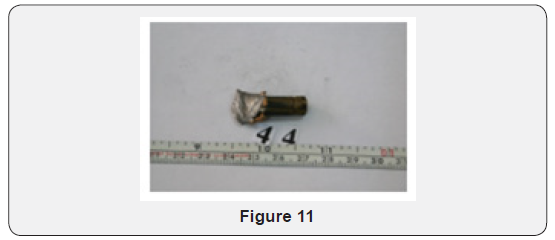



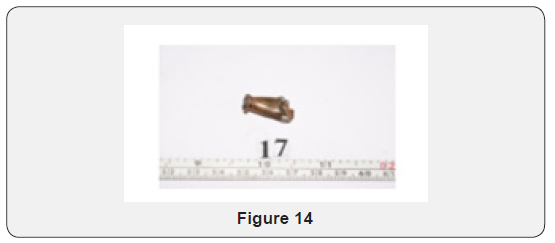

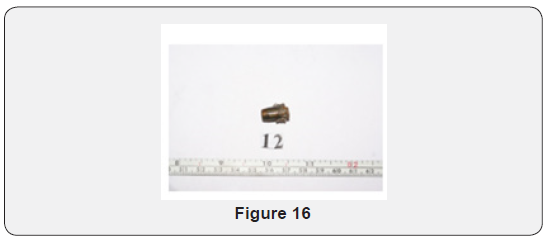
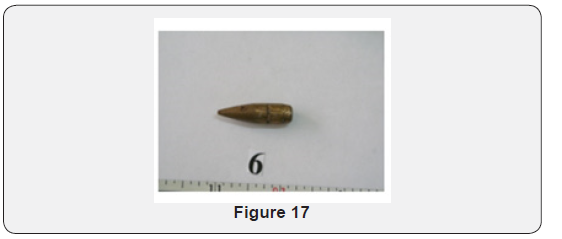

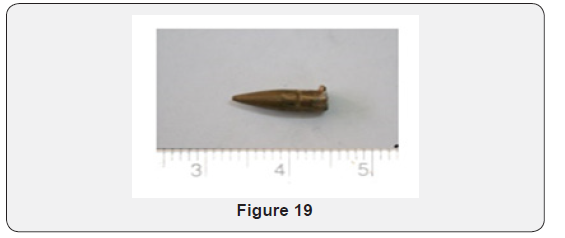
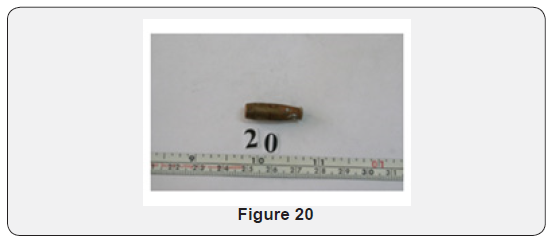
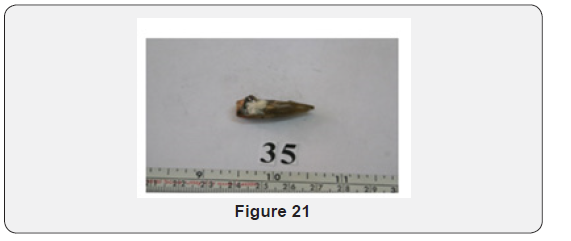





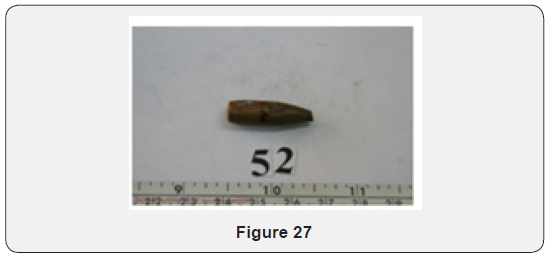

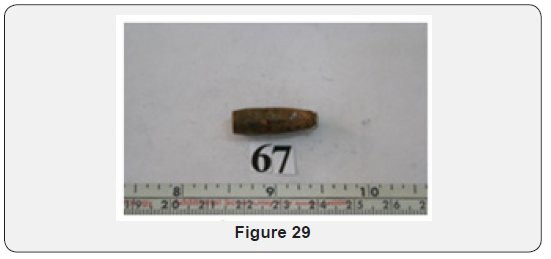
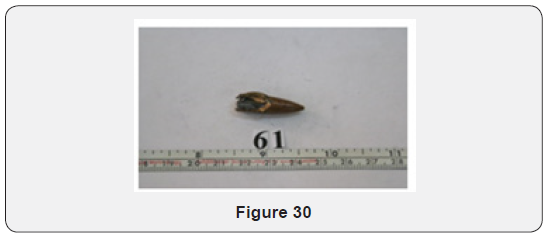


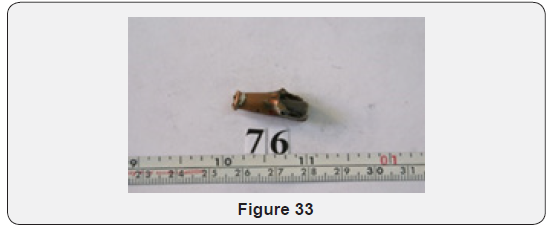
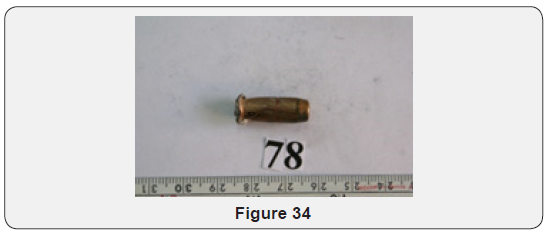
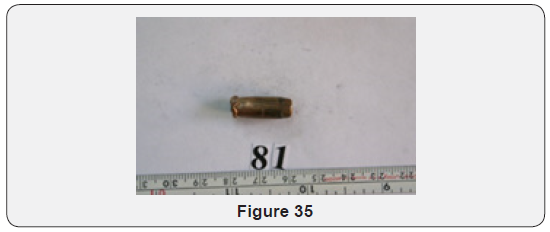
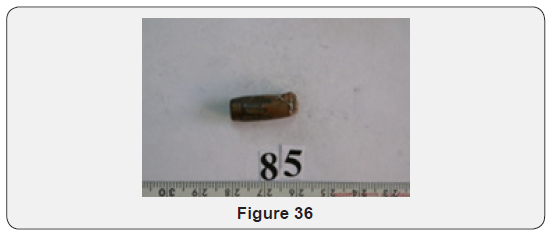
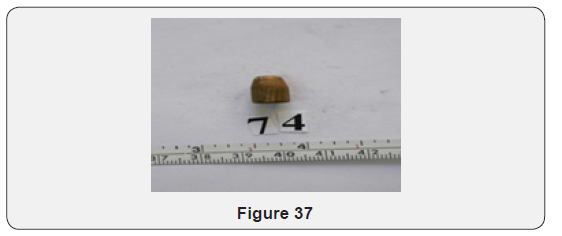
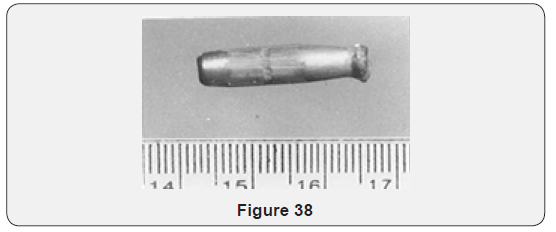


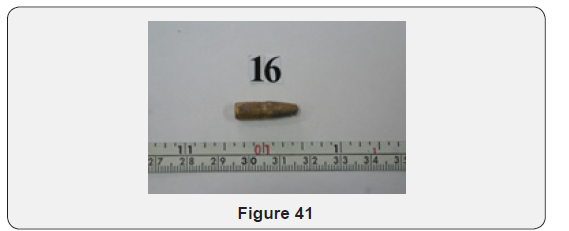
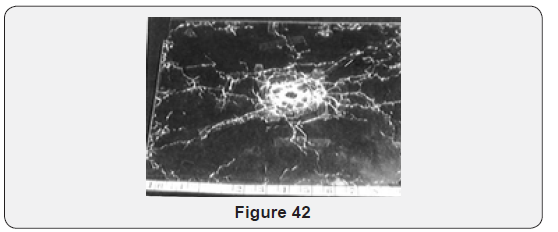



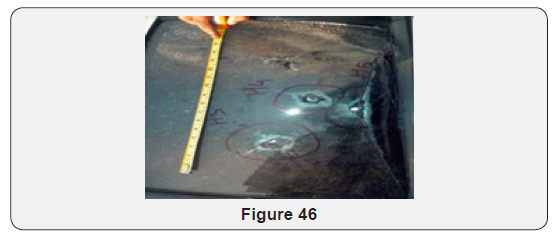

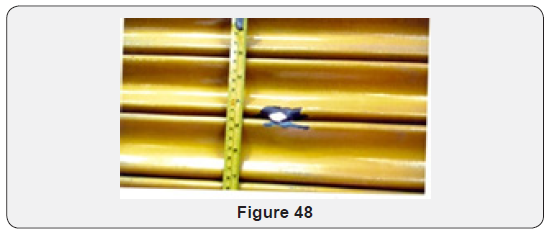
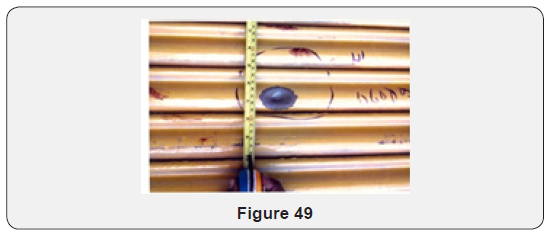


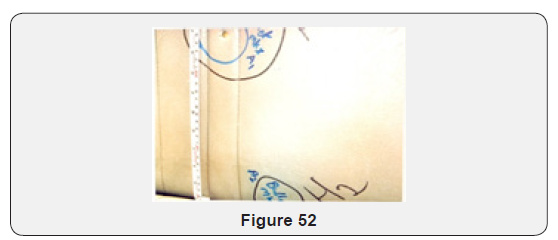

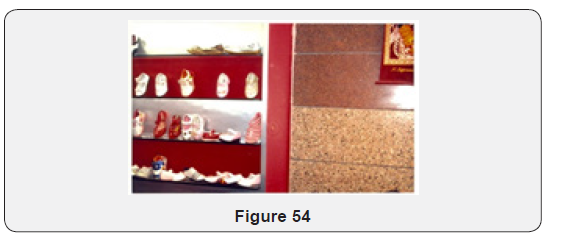
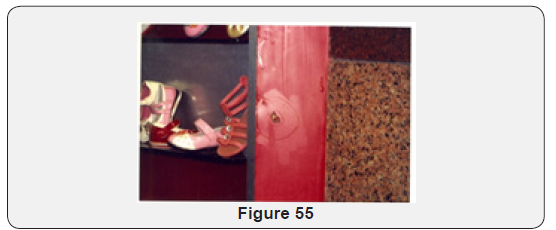
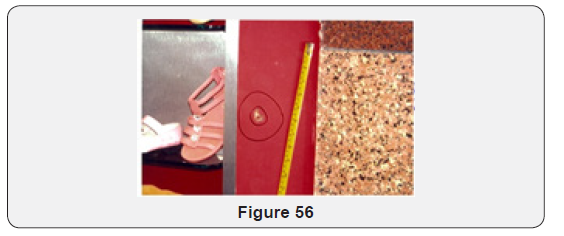




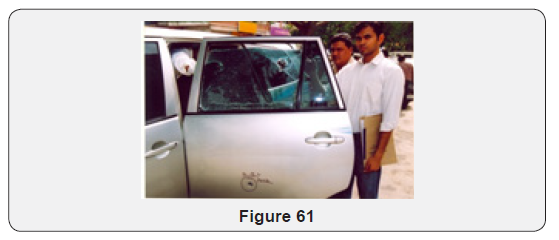
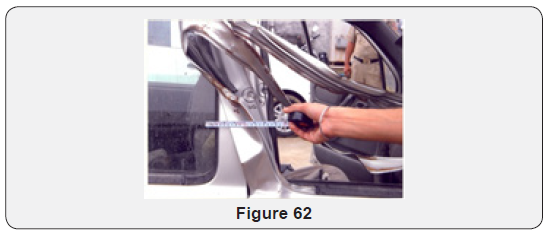
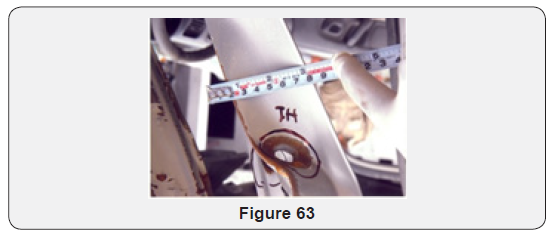
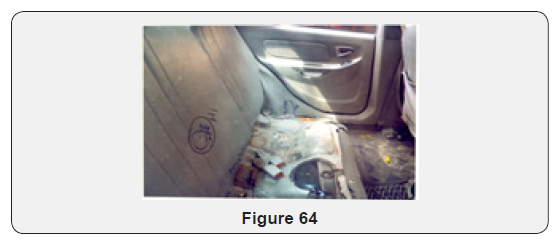
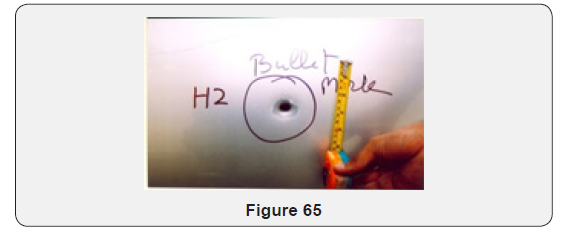
Result and Discussion
It is observed that maximum energy was utilized by soft nose bullet while penetration through glass pane. The physical and microscopic examination of soft nose bullets revealed the typical mushroomed belt mutilated inwards direction near the jacketed portion and these were deformed and mutilated like toothpaste. This type of phenomena is known as tooth paste phenomena. It is also noted that, the jackets of the bullets were recovered in close range due to their light weight and lead core were fond much ahead on the way of trajectory of the projectiles.
The typical mushroomed shapes of lead core as well remaining jacketed portions, deformed bullets at nose portion were found. This type of phenomena was found when the jacketed, non-jacketed, semi jacketed bullets were fired through the brittle materials like glass pane. The main cause behind this phenomena that, during the perforation of bullet (may be jacketed or non-jacketed) in the glass pane target, fine sharp edges of glass particles moving towards the back side of glass with high speed in conical shape manner and jacket or nose of bullet becomes mushroomed inwards. Hence, the ballistics expert, crime scene manager should be aware about the shape of projectiles after passing through various targets, automobile etc. In shooting incident of glass pane, present study may be useful to collect corroborative support at the crime spot. A 9mm caliber jacketed pistol bullet was fired through glass pane, as a result blunt nose portion was observed with minute glass particles were adhered on it.
Figure 38 showed that bullet fired through a regular selfloading (7.65x51mm) rifle on brick block having size about 10- inch x 4 inch. Figure 39-41 showed the bullet fired through .303” rifle on hard surface of brick block. Gunshot hole produced by soft nose bullet of 8mm caliber on poly coated thin film glass pane as shown in Figure 42 The hole produced by .303” caliber on 2mm thickness of aluminum plate is shown in Figure 43.
In a crime scene, during night an unidentified person fired from outside of iron gate and two impact of bullet were found on inside wall portion to terrorism the house owner. Said gunshot holes found present on the wall were shown in Figure 44. On inspection of scene of crime, it is also noted that there are two holes, lower one shows the main hole caused due to lead core and upper one may be produced due to fragmented jacket of bullet. It is noted that lead core is found separated from jacketed portion.
In another crime incident, one inebriated neighbor of victim was entered in the house and fired a shot on victim but due to victim’s presence of mind the shot was missed and hit to wooden showcase. In this case the weapon was 7.65mm improvised weapon with fully jacketed standard bullet. This suspected hole is shown in Figure 45.
In a recent crime case, visited in the capital of India that an accused indiscreetly fired three shots from front side on the victim seated inside vehicle near the driver’s seat. The victim presents in the car got succumbed serious injuries. In this case also the accused has used 7.65mm improvised pistol. The holes produced by 7.65mm jacketed bullet is shown in Figure 46. It is observed that there are three holes marked by crime scene manger as exhibit H3, H4 & H5 as shown in Figure 46.
In another incidence of firing on a car, an accused while driving the bike fired on a person seated in rear seat of moving car from backside. The weapon of offence was 8mm/.315” bore country made pistol. The hole produced by 8mm soft nose bullet on back portion of car is shown in Figure 47. In this case, it is observed that keyhole effect by 8mm bullet is clearly shown. Figure 48-50 show the holes caused due to firing through iron gate was took place in plastic manufacturing factory. Figure 48 shows close up photo of gunshot firing and Figure 49&50 shows entry and exit gunshot holes respectively.
A firing took place on a famous Indian brand car and shooter has fired through front side of car in open market. In this case, the shooter fired a shot on the car at front side. Fortunately, the person sited inside the car was saved with Bruce injuries. The Figure 51 & 52 shows the bullet hole by 7.65mm bore improvised pistol on car seat cushion made from mild Rexene material. Here, the diameter of bullet hole was very small due to elastic property of Rexene.
Figure 53 shows that a shooting incident was took place in area of open market. The close observation of Figure 53 shows that the bullet hole was produced on steel container and its edges are inverted. Some unidentified criminals fired on leather shoe shop and looted all money from the shop owner. The hole created by 7.65mm improvised pistol are shown Figure 54-56. The hole produced by improvised pistol on rear seat of Maruti car as shown in Figure 57. Here small diameter of hole is clearly shown. Figure 58 shows the hole caused due to firing took place on windowpane. It is revealed that beveled effect on glass clearly shows that it could be fired from outside. The typical shape of bullet hole produced by 9mm semi-automatic pistol on brick wall as shown in Figure 59.
In another shooting incident indiscriminate firing was took place on Maruti-Zen car Figure 60. There were Minimum four bullet holes present on it. One hole was present on front rightside door shown in Figure 61. The remaining three irregular holes found on front right side of the car as shown in Figure 62. One clear bullet hole found to be circular on the tin coated by paint as shown in Figure 63. The bullet hole on broken material like glass windowpane was found on front seat as shown in Figure 64. The close-up photograph of hole caused by bullet with improvised 7.65mm pistol on body of car.
Examinations of fired/drecove4red bullets, part of bullets, lead core, core material, and steel cores were having pertinent characteristics of tool marks in the form of striation with their fingerprint’s impression present on the lead core which can identify with firearm, type of target. It is also found that the metallic splinters were formed to be roughly of the shape of the missing portion of the bullet jacket and front portions of the bullet jackets were mushroomed and their jacket portion were mushroomed inwards Figures 3,5-9,31-35. Their characteristics and unique deformations and mushroomed inwards at upper end of jacketed side only found when they were fired on glass target by low and high velocity weapon.
Figure 1-12 showed deformed and fragmented bullets of 8mm/.315’ caliber fired through intermediate targets like glass pane. It also revealed that jacketed portions were mushroomed inwards and lead core were bended at mid portions. In some cases, lead cores were visible at rear end of bullets. Microscopic observation showed the glass particles were adhered on the outer body of projectiles. Figure 13 showed the jacketed portion of 7.62x51mm caliber SLR bullets. It also showed the mushroomed phenomena. Its lead core has been separated from the main body of bullets. Figure 14 showed the deformed and jacketed portion fo7.62x39mm caliber ofAK-47 rifle bullets. Steel core also distinctly visible. Figure 15 &16 showed the fragmented & jacketed portion of SLR bullets. Figure 17-21 showed the jacketed bullets of SLR. It is also found that some deformation at nose, body portions. Here microscopic observation shoes the sign of glass firing from its glass particles. Figure 22-36 showed different deformed and fragmented portion of jacketed bullets of various caliber. It is also observed that nose portions have been deformed and glass particles are adhered on it. Original shape of bullet has been changed. Figure 37 showed a jacketed bullet of 9mm caliber.
Glass particles are adhered on it due to low velocity of bullet may not be deformed. Figure 42-65 shows the different target material collected from scene of crime took place in the capital of India. The dimension of bullet hole on the target material, distance of firing and type of ammunition used in the place of occurrence. It is also observed that normal entry and exit phenomena produced by the firearm were took place like size of entry /exit hole, everted/inverted margin at surrounding the area of the holes etc. presence of gunshot residues (GSR) at entry and exist of the hole. In most of the cases sufficient amount of GSR particles were detected at entry of holes and analyzed by atomic absorption spectrometer. A comparative chart of different target materials like glass windowpane, brick, wooden board and metal sheets is given in Table1.
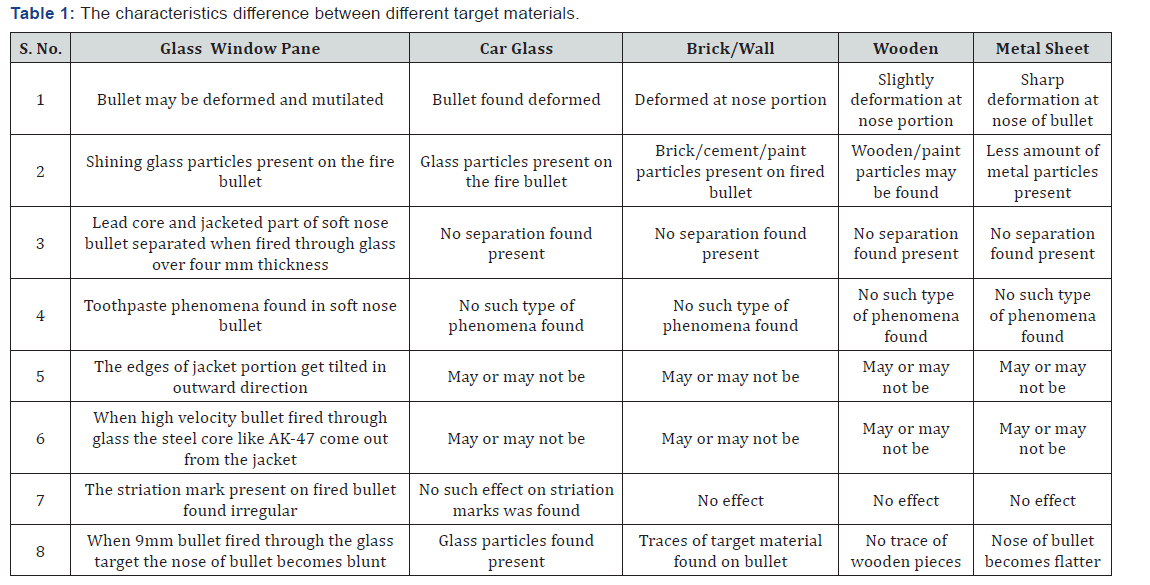
Conclusion
In short, it is concluded that soft nose bullet impacts on glass target are different from any other target material and exhibited typical lead bullet and its jacketed portions mushroomed. On each recovered bullet or target material fine glass particles were adhered on them. They are having unique and individual characteristics marks. This type of phenomena may not be repeated or reproduced at scene of crime from any other target material. To provide concrete opinion forensic scientist/ ballistic expert should carry out simulation experiment in the laboratory from same type of target material, firearmammunition combination. Even same batch of manufactured ammunition should be used during test experimentation. After hitting different target, the shape of bullet varies from weapon to weapon. It also depends upon type of target materials where the projectile hits. It is also observed that inverted and everted pattern of gunshot hole found at the S.O.C. agrees with the entry and exit hole. However, in brittle targets this phenomenon does not occurs.
Acknowledgment
Authors are thankful to DGP, IGP & DIGP Goa Police for their keen interest and constant encouragement
References
- Burad G (1955) The modern shot 2. Pp. 253-265.
- Jauhari M (1978) Identification of firearms, ammunition and firearm injures. printed by Manager, govt. Of India press, Nashik and published by the controller of publications, Delhi-54, India Pp. 62-68.
- Jahuri M, Chatterjee SM, Gosh PK (1974) Remaining velocity of bullets fired through glass plates. Journal of Forensic Science Socienty 14(1): 3-7.
- Hatcher JS (1957) Hatcher’s Notebook stock pole Company. Harries berg-Pennsylvania Pp.511-519.
- Nag NK Sinha P (2007) Indian Academy of Forensic Science. pp: 377-380.
- Frye DA (1957) Unusual Damage to late glass windows. Pol Journal 3: 44.
- Nelson D, Ravel RC Backward fragmentation from breaking point. Journal of Forensic Science Society 7(2): 58-61.
- Waghmare NP, Rao MS, Suresh R, (1967) Biswas M Scientific investigation into the behavior of the window glass under bullet impact. presented at 89th Session of Indian Science Congress, Lucknow University, Lucknow, India.
- NP Waghmare, MS Rao, A Manna, (2003) PK Sen Statistical analysis of impact parameters of soft nose bullet fired through windowpane. Journal of Forensic Science International 135(3): 181-187.






























